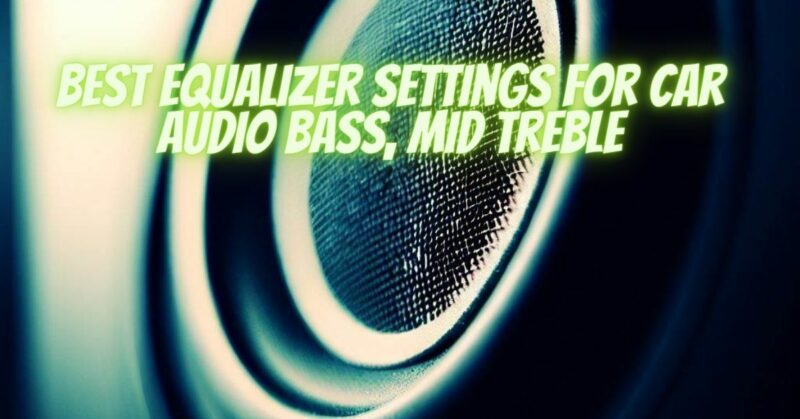Achieving the perfect equalizer settings for your car audio system can greatly enhance your listening experience by optimizing the balance between bass, midrange, and treble frequencies. Finding the ideal settings depends on your personal preferences, the type of music you enjoy, and the quality of your car’s audio equipment. In this guide, we’ll provide a general starting point for setting the bass, midrange, and treble equalizer controls in your car.
1. Setting the Bass (Low Frequencies):
Bass frequencies provide the foundation and impact in your music. Here’s how to set the bass:
- Bass Frequency Range: Adjust the bass control to boost or cut frequencies typically between 60Hz and 250Hz. Start with the bass control set at the midpoint (0) and adjust from there.
- Boost or Cut: Increase the bass control if you prefer a more pronounced and powerful bass response. Decrease it if you want a cleaner, less boomy sound.
- Subwoofer Integration: If you have a subwoofer, consider adjusting its volume separately to fine-tune the low-end frequencies. Subwoofers typically handle frequencies below 100Hz, so their volume control can complement the car’s bass control.
2. Setting the Midrange (Mid Frequencies):
Midrange frequencies provide the clarity and presence in your music. Follow these steps to set the midrange:
- Midrange Frequency Range: Adjust the midrange control to boost or cut frequencies typically between 250Hz and 2kHz. Start with the midrange control set at the midpoint (0) and adjust from there.
- Boost or Cut: Increase the midrange control for a more forward and present sound, ideal for vocals and instrument details. Decrease it if you want a smoother, less pronounced midrange.
3. Setting the Treble (High Frequencies):
Treble frequencies add sparkle and crispness to your audio. Here’s how to set the treble:
- Treble Frequency Range: Adjust the treble control to boost or cut frequencies typically between 2kHz and 16kHz. Start with the treble control set at the midpoint (0) and adjust from there.
- Boost or Cut: Increase the treble control for a brighter and more detailed sound, enhancing the clarity of instruments like cymbals and acoustic guitars. Decrease it if you prefer a warmer, less piercing treble.
Additional Tips:
- Balance and Symmetry: Strive for balance between the bass, midrange, and treble controls to create a well-rounded sound. Avoid extreme settings that can result in a distorted or unbalanced audio experience.
- Use Presets as a Starting Point: Many car audio systems offer preset equalizer settings for different music genres (e.g., rock, pop, jazz). These presets can serve as a good starting point for adjusting your equalizer to suit your preferences.
- Test Different Music Tracks: Use a variety of music tracks that you’re familiar with to fine-tune your equalizer settings. Different songs may benefit from slightly different adjustments.
- Room Acoustics: Keep in mind that the acoustics of your car’s interior can affect how you perceive sound. Experiment with equalizer settings while driving to account for these acoustic factors.
- Avoid Excessive Boosts: Be cautious when boosting frequencies, especially if you’re increasing the bass or treble significantly. Excessive boosts can lead to distortion and speaker damage.
- Use High-Quality Audio Sources: To fully appreciate your equalizer settings, use high-quality audio sources, such as high-bitrate audio files or lossless formats.
Remember that personal preference plays a significant role in equalizer settings. What sounds best to one person may not be ideal for another. Take your time to experiment and fine-tune your equalizer until you achieve the audio quality that suits your taste and enhances your car audio experience.


